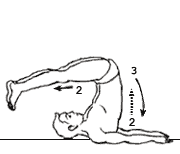How to do Plough Pose, Halasana – Yoga Poses for inversion*
Yoga classes in Milton Keynes
Halasana – the Plough Pose folded-over inversion is wonderfully rejuvenating to the entire nervous system. The abdominal organs are contracted and toned. The neck and shoulders are released from any habitual tension and the spine is stretched to its maximum.
![]()
 1. Lie face up on a cushioned surface such as a soft carpet, folded blanket or a yoga mat. Beginners may prefer to use two or three tri-folded blankets. With blankets under your back, shoulders and elbows forming an upper level, have your head on a lower level. Lying flat relax the shoulders away from the ears. Draw the chin in toward the chest, lengthening the back of the neck.
1. Lie face up on a cushioned surface such as a soft carpet, folded blanket or a yoga mat. Beginners may prefer to use two or three tri-folded blankets. With blankets under your back, shoulders and elbows forming an upper level, have your head on a lower level. Lying flat relax the shoulders away from the ears. Draw the chin in toward the chest, lengthening the back of the neck.
 |  |  |
2. Bend your knees in toward the chest. Press the palms of the hands firmly into the floor as you extend the feet over your head, straightening the legs. If your toes don’t reach the floor, then keep your palms on your lower back. Take care not to overdo it here, because this position is a very strong forward bend that also places a lots of weight on your shoulders and neck. Keep your head in line with the rest of the vertebral column.

4. To come down, lower your buttocks to the floor ,then use your abdominal muscles to help you slowly lower legs, keeping the back of your head on the floor. Practice some counter poses (for example: Fish Pose) afterward to release the neck.
Tips
Gaze: tip of nose
Build-up Poses:
- Double Leg Forward Stretch
- Hare Pose
- Half Shoulder Stand
- Easy Inversion
Counter Poses:
- Revolved Abdomen Pose
- Head Beyond the Knee Pose
- Fish Pose
- Neck Releases
Lighten:
- Bend the knees
- Support your back with the palms of your hands
Effect: Calming, restorative
Plough Pose, Halasana Counter Poses
In yoga we use a counter pose in a sequence; For example, a twist follows a backbend to “neutralise” the spine, or a forward bend follows a backbend to help lengthen the spine and calm the nervous system.
Inversions
Inverted postures improve lymph and venus circulation. They work the heart and boost the immune system. Increased blood supply to the endocrine glands at the throat is the reason why inversions are considered to be hormonal balancers. As holding a position with a whole new relationship to gravity demands a certain steadiness of the body and mind, inversions are calming poses. Inversions let us see things from a new angle. They lesson tiredness and develop concentration. As inversions quiet the mind and settle the system down, they are generally practised towards the end of an asana session, after your body has been well warmed up.
*Caution
Inversions should not be practised by anyone who is suffering from high blood pressure or has eye problems, such as detached retina or glaucoma. They should be avoided by women during menstruation. In the case of previous neck injuries, heart problems or pregnancy, the advice of an experience teacher should be sought. Most inversions are not beginners poses and it is strongly recommended that the postures are learned from an experienced teacher.





